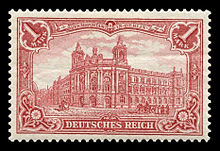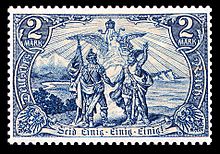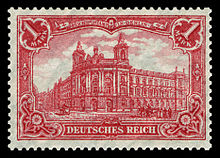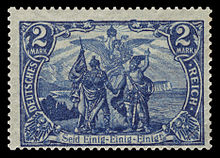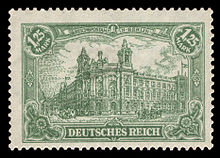Representative representations of the German Empire
A permanent stamp series of the Deutsche Reichspost , which was published between 1900 and 1920, is now referred to as representative representations of the German Empire . The last stamps in the set were valid until September 30, 1923. There is no reliable information about the number of copies.
The stamps in the series, with values between 1 and 5 marks , were mainly used for postal parcels and insured letters . After the First World War and with the onset of inflation , the stamps were also used on registered and insured letters.
The series is sometimes seen as part of the Germania stamp series , although neither shape, motif, or design are identical. The only thing that connects both series is the year of issue and the period of use.
Motifs
The series consisted of four different motifs, these were:
| Motif name | description | draft | Sting |
| Reich Post Office in Berlin | C. Frenzel | ||
| Symbolic representations "North and South" | Genius as a symbol for the unification of North and South Germany. Detail from the painting Victoria by Anton von Werner , part of the " Saarbrücken City Hall Cycle " | W. Lipinsky | W. Roese |
| Unveiling of the Kaiser Wilhelm I monument in Berlin | after a painting by William Pape (1859–1920) | Reichsdruckerei | W. Roese |
| Commemoration of the founding of the empire in the white hall of the Berlin Palace | after a painting by William Pape | Reichsdruckerei | W. Roese |
After the First World War , only the first two motifs, the Reich Post Office and North and South , were reprinted. The brands can be recognized by the slightly changed image motifs. The imperial post office is now flagged on the corner towers and the genius now holds a torch instead of the imperial crown in the north and south motif , the two imperial eagles of the empire have also been replaced by the imperial eagle of the Weimar Republic . Brands that had already been produced from the imperial era were later used with new value imprints.
Brand List
The ratio of the size of the stamps to each other is shown approximately to scale in this article. If the date of issue is written in italics , it is the best known earliest date of use.
| image | description |
Values in marks |
Issue date |
Date of Expiry | MiNr. |
(I)
|
1 | April 1, 1900 | December 31, 1902 | 63 | |
|
2 | June 1, 1900 | December 31, 1902 | 64 | |
|
3 | 2nd August 1900 | December 31, 1902 | 65 | |
|
5 | December 14, 1900 | December 31, 1902 | 66 | |
(II)
|
1 | A: March 30, 1902 B: August 30, 1902 |
October 31, 1922 | 78 (A + B) |
|
|
2 | March 20, 1902 | October 31, 1922 | 79 A | |
|
3 | A: March 20, 1902 B: February 20, 1904 |
October 31, 1922 | 80 (A + B) |
|
|
5 | A: March 20, 1902 B: May 22, 1902 |
October 31, 1922 | 81 (A + B) |
|
(III)
|
2 | A: May 24, 1902 B: December 8, 1902 |
October 31, 1922 | 82 (A + B) |
|
(IV) (peace pressure)
|
1 | December 9, 1905 | October 31, 1922 | 94 A I | |
|
2 | February 25, 1906 | October 31, 1922 | 95 A I | |
|
3 | March 21, 1911 | October 31, 1922 | 96 A I | |
|
5 | January 24, 1906 | October 31, 1922 | 97 A I | |
(V) (war pressure)
|
1 | A: January 30, 1918 B: September 17, 1915 |
October 31, 1922 | 94 (A + B) |
|
|
2 | A: May 31, 1916 B: April 13, 1916 |
October 31, 1922 | 95 (A + B) |
|
|
3 | A: May 4, 1919 B: October 9, 1918 |
October 31, 1922 | 96 (A + B) |
|
|
5 | A: May 18, 1916 B: February 8, 1918 |
October 31, 1922 | 97 (A + B) |
|
(VI)
|
1 | May 1920 | September 30, 1923 | A113 | |
|
1.25 | March 15, 1920 | September 30, 1923 | 113 | |
|
1.50 | March 15, 1920 | September 30, 1923 | 114 | |
|
2.50 | March 15, 1920 | September 30, 1923 | 115 | |
(VII)
|
1.25 | June 1920 | September 30, 1923 | 116 | |
|
1.50 | June 1920 | September 30, 1923 | 117 | |
|
2.50 | June 1920 | September 30, 1923 | 118 |
Bavaria
In Bavaria, which had its own post office shelf until 1920 , the market values of 1, 2, 3 and 5 marks were used in 1919 with the imprint "Free State of Bavaria" (Michel numbers 148 to 151).
Foreign post offices
In the post offices abroad, the market values were used as follows:
- China: Reichspost issue with red imprint "China"; From October 1, 1905 German Reich edition with imprint "China" in Gothic script and value in (silver) dollars.
- Morocco: Reichspost issue with "Marocco" imprint and value in centimos / peseta currency; from September 30, 1905 German Reich edition with overprint "Marocco" in Gothic script and value in centimos / peseta currency, from 1911 with overprint "Morocco".
- Turkey: Reichspost issue with overprint in piastre currency; from October 1, 1905 German Reich edition with imprint in piastre currency in Gothic script.
In the German colonies of that time , the market values (and the corresponding values of the areas not counting in marks such as Kiautschou and German East Africa ) of the Imperial Yacht stamp series were used.
Casting issues
- Belgium: Values of 1, 2 and 5 marks overprinted in franc currency with "Belgium" printed in Gothic script.
- Stage area west (northeastern France): From December 1, 1916 overprinted values of 1 and 2 marks without additional country information.
- Postal area Ober-Ost: From January 15, 1916 with "Postgebiet Ob. Ost" overprinted value at 1 mark.
- Poland, Romania, stage area 9th Army: unlike the Germania stamps, no overprint of the market values.
Voting areas, Saar area, Memel area, Gdansk
The market values have been overprinted in the Allenstein voting area , in the Marienwerder voting area , in Upper Silesia (as part of the "Oppelner Notausgabe"), in the Saar area , in the Memel area and in Gdansk .
Individual evidence
literature
-
Michel catalog
- Germany special
- Letters Catalog
Web links
collection





